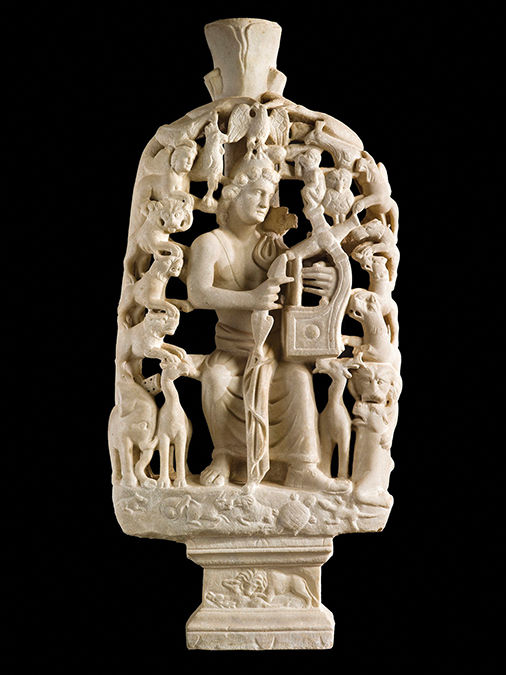One of the largest and historically important displays of Byzantine objects from Greece ever presented in Los Angeles comprises the current exhibition, “Heaven and Earth: Art of Byzantium” at the Getty Villa and Getty Center.
The exhibition features 167 objects — including mosaics, icons, sculptures, manuscripts, metalwork, ceramics and more — and was drawn from 34 collections throughout Greece. It runs through Aug. 25 at the Getty Villa (in Pacific Palisades) and June 22 at the Getty Center (in Brentwood).
The exhibit took three years to prepare on the Getty side even though the exhibit came to California fully curated, says Getty curator Mary Louise Hart. Greek scholars, museum directors, culture officials and more came up with the themes and overall vision of the exhibition which traces the transformation of the Byzantine culture from the ancient pagan world to the new Christian Byzantine Empire, explained Hart.
The Getty Center displays a series of six rare illuminated manuscripts from Greek collections that are paired with works from the Getty’s own holdings that display the Byzantium influence on surrounding cultures. The main host of the exhibition, however, is located at the Getty Villa which presents objects divided into five themed sections or rooms.
One of the more fascinating rooms is the “Antiquity to Christianity” where the transition from pagan to Christian culture is found in sacred images and everyday objects.
“For a time, paganism and Christianity existed side-by-side,” explains Hart who points to the example of the Head of Aphrodite, a lovely marble bust of the goddess who has the sign of the cross chipped on her forehead. “Her duties were being transferred; her power was being repurposed,” describes Hart.
Indeed, the hybrid culture makes sense when you realize that people who adopted Christianity were doing so with a background and foundation in classical antiquity. Greco-Roman deities were often depicted alongside Old Testament subjects and crosses evoking the Passion of Christ, continues Hart. “People didn’t automatically turn off their former beliefs. Those beliefs became the foundation of the new religion.”
Equally engaging is the sculptured marble table leg “Christ as Orpheus” which depicts Jesus as the charming Orpheus who lied his way in and out of the afterlife.
“This is a delicate and sweet image especially with the peaceful animals surrounding Christ,” says Hart. “But when you look closer you realize that some of the animals are attacking each other. So there’s plenty going on here.”
Even when Christianity became the state religion — with the ancient Greek city of Byzantium renamed Constantinople as the new capital of the Roman Empire in A.D. 330 — the visual art, architecture and imagery that was produced was profound and often very spiritual.
Hart points to a mosaic piece depicting a fountain on display that was part of the first large Christian basilica in the fifth century. The entire inside of the church was covered with this shimmering gold, says Hart.
“Imagine entering this holy place with incense burning, gold vestments on the priests and all the gold reflections,” she says. “It would have been an out of the body experience for worshippers.”
Many of the icons at the exhibit are important to the Greek Orthodox Church including the Man of Sorrows, a processional icon that was brought out for Good Friday services. “It’s powerful because even though Christ is dead here, his skin tones are warm,” she says.
Likewise, the Epitaphios cloth on display depicts Christ laid in a tomb flaked by scenes of his life. “This item is a national treasure in Greece,” says Hart about the elaborately decorated silk and linen cloth that’s used in a procession out and back into the church usually on Holy Saturday.
Historically, icons developed from a purely devotional and spiritual experience to one that incorporate an artist’s personal interpretation. Once made strictly by monks and religious, as the culture grew, artists began to create icons as objects of art.
One of the most impressive and powerful icons of this type at the exhibit is a crucifixion by the artist Andreas Pavias (1440-1504). “This icon contains just about every story you’ve heard about the moment that Christ died,” says Hart. The intricate icon features a temple breaking, weeping angels, a devil taking the soul of the evil crucified criminal, an earthquake; Christ’s blood dripping on the skull of Adam — the list goes on.
“You can stand in front of it for hours mesmerized. The art and imagery is so powerful. Every place you stand you will see something new.”
The Getty Center is located at 1200 Getty Center Dr., Brenwtood. The Getty Villa is located at 17985 Pacific Coast Hwy., Pacific Palisades. For hours and admission, call (310) 440-7300 or visit http://www.getty.edu/museum/.

